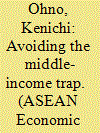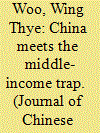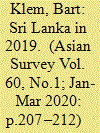| Srl | Item |
| 1 |
ID:
088793


|
|
|
| 2 |
ID:
116496


|
|
|
|
|
| Publication |
2012.
|
| Summary/Abstract |
We follow Woo (2011) in using the Catch-Up Index (CUI) to define the middle-income trap and identify the countries caught in it. The CUI shows that China became a middle-income country in 2007-2008. We see five major types of middle-income trap to which China is vulnerable: (a) fiscal stress from the nonperforming loans generated by the interaction between the lending practices of the state banks and the innate desire by state enterprise managers to over-invest and embezzle; (b) the frequent use of macro-stabilization tools that hurt long-term productivity growth; (c) flaws in socio-political governance that exacerbate social tensions; (d) ineffective management of environmental challenges that threaten sustainable development; and (e) inept handling of international economic tensions that could unleash trade conflict. We recommend new governance principles and management methods to prevent China from falling into these five types of middle-income trap.
|
|
|
|
|
|
|
|
|
|
|
|
|
|
|
|
| 3 |
ID:
111483


|
|
|
|
|
| Publication |
2012.
|
| Summary/Abstract |
Through review of relevant studies and analysis, this article indicates that the "middle-income trap" is in line with the framework of the mainstream economic growth theories, and, therefore, it is a useful concept through which we can analyze economic growth phenomena in specific economic growth phases. The empirical experiences of many countries also indicate that at specific middle-income stages, economies with high rates of growth tend to encounter economic slowdown or even stagnation. The article shows that China is facing the challenge of determining how to move smoothly beyond the middle-income stage of economic development, while taking into account the shifting population structure, changing resource endowment and growth patterns. The article, drawing on international experiences, puts forward several policy suggestions relating to improvement in total factor productivity, expansion of human capital accumulation and deepening of system and government function reforms.
|
|
|
|
|
|
|
|
|
|
|
|
|
|
|
|
| 4 |
ID:
172480


|
|
|
|
|
| Summary/Abstract |
Sri Lanka was confronted with three interrelated crises in 2019: the unresolved gridlock of last year’s constitutional crisis; the Easter bombings and their turbulent aftermath; and the coming to a head of fiscal shortfalls and debt burdens. Growth is stalling, living costs are rising, deficits are widening, and the price of Sri Lanka’s debt is weighing heavily on the government budget. In the presidential elections, Gotabaya Rajapaksa, heir of the Rajapaksa dynasty, prevailed with a landslide.
|
|
|
|
|
|
|
|
|
|
|
|
|
|
|
|